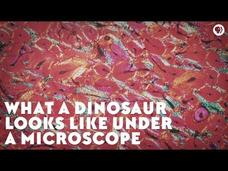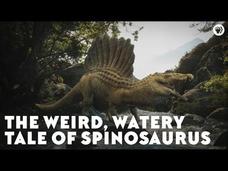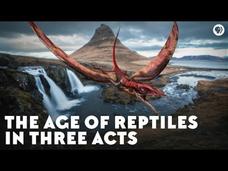PBS
What a Dinosaur Looks like under a Microscope
How do scientists determine the age of a dinosaur when it died? Viewers earn how scientists make slides of dinosaur fossils and how they use these images to determine age at death. Part of a larger Eons series from PBS, these beautiful...
PBS
Inside the Dinosaur Library
Where do fossils that aren't on display in a museum go? Learn about the dinosaur collections at the Museum of the Rockies as part of the larger PBS Eons series of videos. The collections manager explains how they care for fossils and...
PBS
What Was the Ancestor of Everything?
As part of evolution species branch off of others species. But what did the original limb look like? Young scientists discover the exciting study of the last universal common ancestor as they hear from specialists in multiple scientific...
PBS
How the Squid Lost Its Shell
The ancestors of squid and octopus used shells as a form of defense. Pupils learn how cephalopods evolved without shells and the adaptations required to survive without one. Viewers learn how scientists know about these changes and the...
PBS
How the Chalicothere Split In Two
How is it that the same animal, living in the same place, at the same time, evolved into two different species? As part of a larger series, an engaging video explains the rise of the chalicothere, the split in evolution, and eventually...
PBS
The Weird, Watery Tale of Spinosaurus
While scientists have know about dinosaurs that flew in the air, lived on land, and swam in the water, a episode from the PBS Eons series reveals recent discoveries of a dinosaur that was semi-aquatic—the first known semi-aquatic...
PBS
The Age of Reptiles in Three Acts
Reptiles survived the largest extinction event on the planet and then they grew into the most dominant class of the Mesozoic Era. They quickly evolved into giants on land, sea, and air. In an episode of the PBS Eons series viewers learn...
PBS
From the Fall of Dinos to the Rise of Humans
We live in the Cenozoic Era, and most of the animals we recognize first appeared in this era. However, the animals that existed at the start of the era bear little resemblance to present day. As one part of a larger series, individuals...
PBS
That Time It Rained for Two Million Years
What would happen if all of the land on Earth received as much rainfall as the temperate rain forest? The vast desserts would be altered, the animals would adapt or die, and the types of plants available would quickly shift. This is what...
PBS
Why Triassic Animals Were Just the Weirdest
Normally when two species look similar, they are closely related. However, this doesn't seem to apply to the Triassic animals. Learn why these familiar looking animals are not actually related to today's animals. Viewers come to...
PBS
Where Did Viruses Come From?
When did things start going viral? Travel back through eons of history and learn about the origins of viruses. Part of a larger series, the lesson discusses what scientists already know and how they study viruses. The video also details...
PBS
The Facts About Dinosaurs and Feathers
Did the T. Rex have feathers? A video from the Eons series playlist explains the exciting recent findings about dinosaurs and feathers. It details the evidence, the research, and our current understanding. It also considers why dinosaurs...
PBS
Virus Wars
Unending war, battles on every front, increasing offenses and defenses as the sides adjust to each other ... these phrases describe your body fighting viruses. From a common cold to deadly Ebola, cells adjust and defend life themselves....
PBS
Protein Synthesis
The smallest man-made factory measures less than 400 square feet. The smallest nature-made factory is inside your body. An engaging video describes the factory inside your cells. The narrator details transcription and translation along...
PBS
The RNA Origin of Life
Scientists believe RNA is the origin of all life on Earth, carrying genetic information long before DNA developed. Viewers comprehend this idea as they learn the functions of RNA, DNA, and proteins. Evolution of RNA, cells, molecules,...
PBS
The RNA Enigma
Folding a fitted sheet seems impossible, but folding RNA seems like a game. Viewers learn how they can help scientists prevent or cure diseases. It emphasizes the need for human help because computers struggle with these puzzles.
TED-Ed
Cannibalism in the Animal Kingdom
Many consider cannibalism to be the last resort before starvation. During an engaging video, scholars gain knowledge of cannibalism in the animal kingdom. It addresses common misconceptions and recently discovered patterns before pupils...
TED-Ed
What Causes Body Odor?
Can your diet change the smell of your armpits? Scholars learn the truth behind this and other factors that influence body odor. It covers the biology of what is happening as well as the ways to prevent or cover the offensive odor. To...
TED-Ed
The Science of Skin
Almost one fifth of your weight is in your skin, but why does it weigh so much? Viewers learn about the integumentary system and the many functions it performs constantly to keep them safe. Then, they answer multiple choice and...
PBS
Harriet Beecher Stowe: Uncle Tom's Cabin
Harriet Beecher Stowe's passion for abolitionism culminated when Congress passed the Fugitive Slave Act of 1850, forcing Northern states to become complicit in the act of slavery. A short video dramatizes the events preceding the...
Pentatonix
Evolution of Music - Pentatonix
Explore music through the decades with an engaging video brought to you by the 5-part harmony acapella group, Pentatonix. Genuine musical talents sing through a variety of popular music from the 11th century to the 2010's. Artists...
TED-Ed
What Are Mini Brains?
Scientists grow tiny brains outside an organism in their labs. How this is accomplished and why become the central focus of a video and discussion. After viewing the core lesson, ten questions check for content mastery and prepare young...
TED-Ed
Why do Animals Form Swarms?
Swarms contain no leader, yet often act with an intelligence higher than any individual member. Birds, insects, and fish all commonly swarm for a variety of reasons. Scholars learn about swarming behavior in a short video before...
Physics Girl
Avoid Electric Shock Getting Out of a Car!
Can you avoid static shocks? As part of a larger physics series, an electric video explains what a static shock is and why it happens. Then, the narrator offers an idea for reducing your shock when exiting a car. She also includes a few...

























